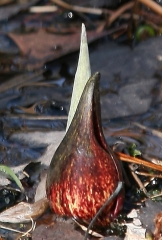Snow may still be covering the ground here in West Michigan, but meteorological spring has sprung and March is on the march. Temperatures are trending warmer, and while the mid to upper thirties may not be anything to brag about, the vernal transition is at hand. You can see it in the mist lying over the snowfields. You can hear it in the spring songs of a few optimistic early-birds. It’s there on the weather maps in the form of lows sweeping northeastward out of the Plains, tugging moisture up out of the Gulf of Mexico. And soon, those of us who love native plants will discover it poking up through remnant drifts in wooded swamps in the form of Michigan’s earliest wildflower, the skunk cabbage.
Symplocarpus foetidus may not be bouquet material, but I’m fond of it. Too low-key to be striking, skunk cabbage is nevertheless remarkable, a demonstration of genius walking hand in hand with humility. Its small, odd-looking, purple-cowled flowers, rising amid the languishing snow drifts in mid to late March here in the north, resemble nothing else the woodland has to offer. Once I see them, I know that spring has gotten truly, irrevocably underway. (Click to enlarge image.)
Indeed, as spring’s first flowering harbinger, skunk cabbage makes its own modest contribution to the ambient temperature through its unique ability to generate heat. Skunk cabbage flowers literally melt their way through the snow, generating temperatures upwards of 70 degrees in their immediate vicinity. These little heat engines serve as microclimates for certain insects; each bloom is, in a sense, a world unto itself.
Speaking of the blooms, the mottled hood that resembles a monk emerging headfirst from the earth is not the actual flower. It is a structure called a spathe, and it wraps around the stubby yellow spike on which the tiny flowers grow.
Tear off just a small piece from any part of the plant–the spathe or, in a few more weeks, the large, lush green leaves–and give it a sniff. You’ll instantly discover how the skunk cabbage got its name. It’s not a plant known for its mild, winsome aroma.
The lowly skunk cabbage may rank as America’s oldest flowering herb. Speculation is that, in a supportive environment, Symplocarpus foetidus may live for hundreds of years. That stand of skunk cabbage you traipsed past without giving a second thought to on your hike through the woods may have gotten its start before the Mayflower landed!
Storm chasers greet the spring looking up at the sky, sniffing the moisture returning from the Gulf of Mexico and watching for tumbled clouds to rise through the troposphere and throw tantrums of thunder, lightning, and hail. But it pays to look down as well. The advance guard of spring’s convective pyrotechnics may be an unobtrusive little plant peering up at you beside a snow drift in the woods.


